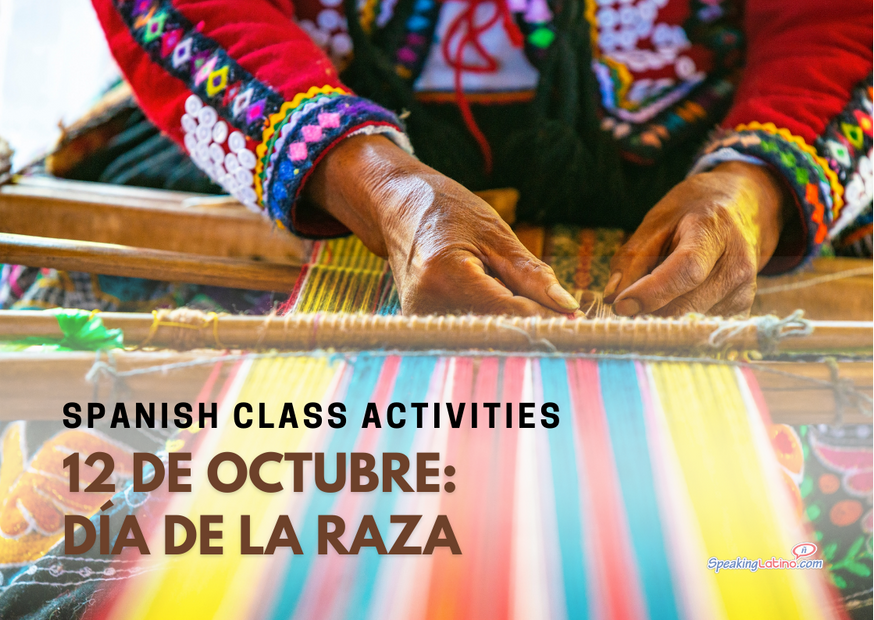
In Latin America, October 12 is celebrated as Dia de la Raza, which marks the arrival of Christopher Columbus in the Americas in 1492.
October 12 is celebrated as “Day of Indigenous Resistance” in Latin America. It is a day to commemorate the struggles and achievements of indigenous people throughout the region, to promote indigenous cultures and values, and to stand in solidarity with them. The day also serves as a reminder that indigenous communities still face major challenges such as unequal access to education, discrimination, poverty, racism and land rights violations.
 12 de octubre (Hispanoamérica) Cultural Presentation and Activities – Introduce your students to what happened on October 12th (Columbus Day – Indigenous Peoples’ Day) when the Spanish arrived in the Americas in 1942 and how this date is celebrated today. Use these ready-to-use Google Slides in Spanish and English for them to bring cultural traditions to your classes.
12 de octubre (Hispanoamérica) Cultural Presentation and Activities – Introduce your students to what happened on October 12th (Columbus Day – Indigenous Peoples’ Day) when the Spanish arrived in the Americas in 1942 and how this date is celebrated today. Use these ready-to-use Google Slides in Spanish and English for them to bring cultural traditions to your classes.
 ¿Qué es la apropiación cultural? – La identidad pública y privada – Identidad nacional y étnica – Audiovisual interpretive communication activity where students learn what cultural appropriation and cultural assimilation is.
¿Qué es la apropiación cultural? – La identidad pública y privada – Identidad nacional y étnica – Audiovisual interpretive communication activity where students learn what cultural appropriation and cultural assimilation is.
Indigenous People Spanish Scaffolded Cultural Activities
- Tecnología de la Información y pueblos indígenas – La ciencia y la tecnología – Efectos de la tecnología en sí mismo y en la sociedad – Audiovisual interpretive communication activity where students learn how technology and social media is revitalizing indigenous culture and language.
- La belleza indígena – La belleza y la estética – Definiciones de belleza – Speaking production activity for novice, intermediate, and advanced students to practice physical traits vocabulary and descriptions.
- Pueblos indígenas en América Latina Hoy – Los desafíos mundiales – Población y demografía – Audiovisual interpretive communication activity where students learn about the indigenous population in Latin America and their challenges.
 Pueblos indígenas en Perú – Familias y comunidades – Costumbres y valores – Audiovisual interpretive communication and interpersonal communication activity where students learn about how indigenous communities live in Peru.
Pueblos indígenas en Perú – Familias y comunidades – Costumbres y valores – Audiovisual interpretive communication and interpersonal communication activity where students learn about how indigenous communities live in Peru.
- El pueblo Diaguita – La identidad pública y privada – Identidad nacional y étnica – Audiovisual interpretive communication activity about this Pre-Colombian group that lived between Argentina and Chile.
- Arte Shipibo de la Selva Peruana – La identidad privada y pública – La identidad nacional y étnica (Perú) – In this reading comprehension activity, students learn about Shipibo Art, an art expression from the Amazon in Peru.
- La desigualdad étnica en Panamá – La identidad pública y privada – La enajenación y la asimilación (Panama) – In this visual and oral activity, students learn about the ethnic inequality in Panama through images, videos, and official statistics.
 Ofrendas a la Pachamama: Vida contemporánea – Tradiciones y valores sociales (Bolivia) – In this Reading Comprehension activity, students learn about Pachamama day, a tradition in Bolivia when people celebrate with offerings to the Earth.
Ofrendas a la Pachamama: Vida contemporánea – Tradiciones y valores sociales (Bolivia) – In this Reading Comprehension activity, students learn about Pachamama day, a tradition in Bolivia when people celebrate with offerings to the Earth.
- Color Rosa Mexicano: La identidad pública y privada – Identidad nacional y étnica (México) – In this project, students learn about the traditional colors of Mexico, what a logo is, and how the colors represent its culture.
- Tikal: La ciencia y la tecnología – Las innovaciones tecnológicas (Guatemala) – In this reading comprehension activity, students read about Tikal, a Mayan Civilization in Guatemala, learn about their culture, and the archeological discoveries.
Indigenous Traditions Spanish Class Activities
- Tamales (Latinoamérica) – Presentation – Introduce your students to Tamales from Latin America. Use these ready-to-use Google Slides in Spanish and English for them to bring cultural traditions to your classes.
 Muñecas Quitapenas (Guatemala) Presentation – Introduce your students to Worry Dolls or Muñecas Quitapenas from Guatemala. Use these ready-to-use Google Slides in Spanish and English for them to bring cultural traditions to your classes.
Muñecas Quitapenas (Guatemala) Presentation – Introduce your students to Worry Dolls or Muñecas Quitapenas from Guatemala. Use these ready-to-use Google Slides in Spanish and English for them to bring cultural traditions to your classes.
- Ekeko (América del Sur) – Presentation – Introduce your students to El Ekeko from South America. The Ekeko represents abundance and prosperity in the mythology and folklore of the people from the Peruvian and Bolivian Altiplano. Use these ready-to-use Google Slides in Spanish and English for them to bring cultural traditions to your classes.
-
Machu Picchu – Perú – Cultural Presentation & Activities (Spanish & English) – Introduce your students to Machu Picchu in Peru. Use these ready-to-use Google Slides in Spanish and English for them to bring cultural traditions to your classes.
 Las Cholitas – Bolivia – Cultural Presentation & Activities – “Originally defined as women from the “pueblos” living in the cities, they have always been easily distinguishable by their unique style of dress and their indigenous features.” Use these ready-to-use Google Slides in Spanish and English for them to bring cultural traditions to your classes.
Las Cholitas – Bolivia – Cultural Presentation & Activities – “Originally defined as women from the “pueblos” living in the cities, they have always been easily distinguishable by their unique style of dress and their indigenous features.” Use these ready-to-use Google Slides in Spanish and English for them to bring cultural traditions to your classes.
Indigenous People Biographies
- Biography – Isabella Springmühl (Fashion Designer) – Guatemala (SPA & ENG) – Introduce your students to notable Hispanics/Latinos in your classes. Use these ready-to-use Google Slides for them to discover the incredible life and achievements of Isabella Springmühl.
- Biography – Rigoberta Menchú (Indigenous Leader) – Guatemala (Spanish & English) – Introduce your students to notable Hispanics/Latinos in your classes. Use these ready-to-use Google Slides for them to discover the incredible life and achievements of Rigoberta Menchú.
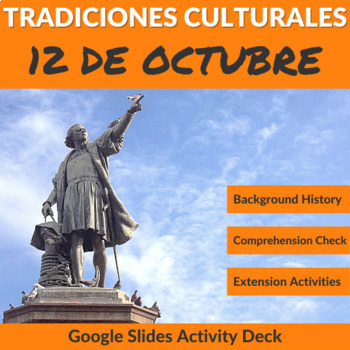

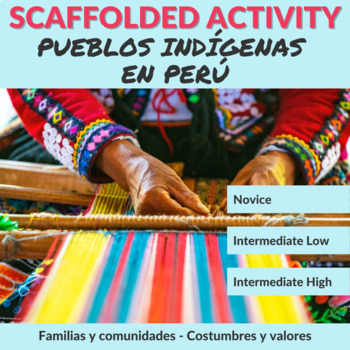 Pueblos indígenas en Perú – Familias y comunidades – Costumbres y valores
Pueblos indígenas en Perú – Familias y comunidades – Costumbres y valores Ofrendas a la Pachamama: Vida contemporánea – Tradiciones y valores sociales (Bolivia)
Ofrendas a la Pachamama: Vida contemporánea – Tradiciones y valores sociales (Bolivia)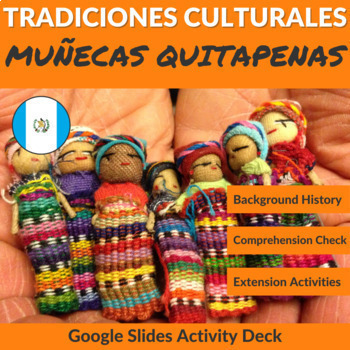 Muñecas Quitapenas (Guatemala) Presentation
Muñecas Quitapenas (Guatemala) Presentation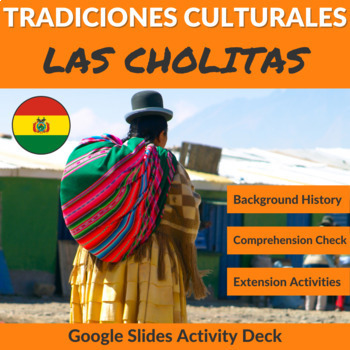 Las Cholitas – Bolivia – Cultural Presentation & Activities
Las Cholitas – Bolivia – Cultural Presentation & Activities